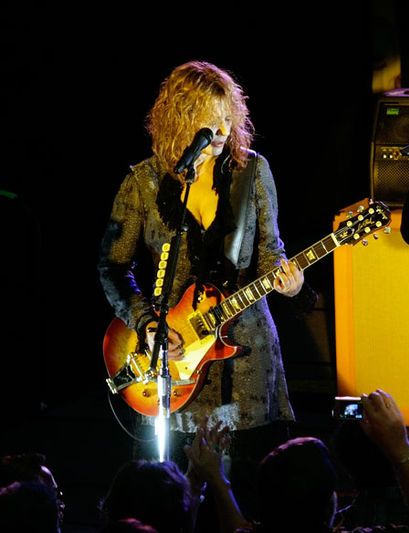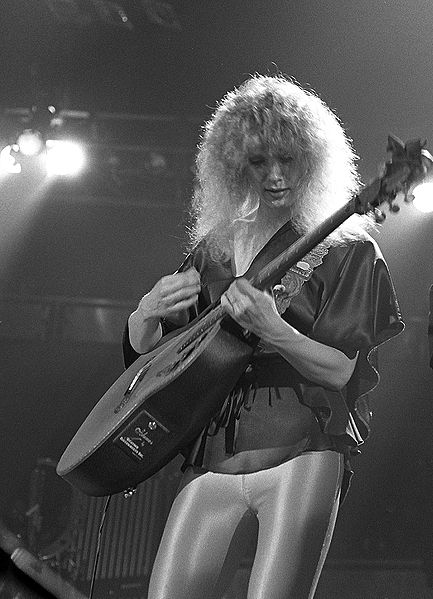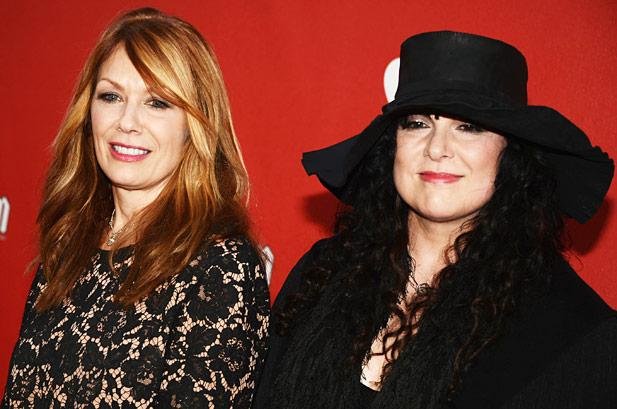BIOGRAPHICAL DETAILS
Full Name: Nancy Lamoureux Wilson
Description: Vocalist, Guitarist,USA
Known For: Heart (Band)
Instruments: Voice
Music Styles: Rock
Location: United States of America
Date Born: 16th March 1954
Location Born:San Francisco, , California, United States of America
Photo Comments: The above image is intended for those who wish to reuse material (text and/or graphics) from the Wikipedia projects — on their own website, in print, or otherwise. It focuses on Commons as this is explicitly a collection of reusable media.
CONTACT DETAILS
Web Site:Nancy Wilson
Other Links: See below:
YOUTUBE VIDEO
BIOGRAPHICAL PROFILE
Nancy Wilson
Nancy Lamoureaux Wilson (born March 16, 1954) is an American musician, singer, songwriter, actress, and producer. She and her older sister Ann are the core of the rock band Heart.
American singer and guitarist who, with her older sister Ann, became a part of the Seattle band Heart.
Dreamboat Annie came out on Mushroom Records in 1976, and their second single, “Crazy On You”, was a hit.
Nancy Wilson was born in San Francisco, California. She is the youngest of three sisters (Lynn, Ann and Nancy), who grew up in Southern California and Taiwan before their US Marine Corps father retired to the Seattle suburb of Bellevue.
On February 9, 1964, when Nancy and Ann watched the Beatles perform on The Ed Sullivan Show, she and her sister instantly wanted to be like the band. In an interview she said, “The lightning bolt came out of the heavens and struck Ann and me the first time we saw the Beatles on ‘The Ed Sullivan Show.’ … There’d been so much anticipation and hype about the Beatles that it was a huge event, like the lunar landing: that was the moment Ann and I heard the call to become rock musicians. I was seven or eight at the time. … Right away, we started doing air guitar shows in the living room, faking English accents, and studying all the fanzines.”
Two of Nancy’s friends who could sing joined Nancy and Ann to form their first music group. Calling themselves the Viewpoints, they were a four-part harmony vocal group. Later that year, Ann bought her first guitar, a Kent acoustic, with money given to her by her grandmother. Nancy’s parents soon bought her a smaller guitar, but since it would not stay in tune, Ann’s guitar became Nancy’s too.
On August 25, 1966 the Beatles played at the Seattle Center Coliseum. The Viewpoints got tickets. Nancy’s mother had made matching outfits like the ones that the Beatles wore so that the girls would “look professional”. The girls wore these outfits to the concert
Early performances
The Viewpoints’ first public show was a folk festival on Vashon Island in 1967. In Nancy’s words: “We didn’t get paid, but since there were people sitting in folding chairs, we considered it a professional gig.” The band played at venues such as drive-ins, auto shows and church socials. Nancy’s and Ann’s public debut as a duo took place on Mother’s Day at their church.
Later at a Youth Day event at their church, the duo chose to sing “The Great Mandala (The Wheel of Life), by Peter, Paul and Mary, Elvis Presley’s “Crying in the Chapel,” and The Doors’ “When the Music’s Over”. The anti-war sentiment, and the irreverence for the venue in some of the lyrics, offended a number of people. By the time they finished, more than half had walked out. Nancy felt some guilt over the event, but “it lit a bonfire under us because we saw for the first time that what we did on stage could have an impact on an audience.”
First record
While a senior in high school, Ann joined a band. Their drummer knew a country songwriter who needed a band to play on his songwriting demos, so the band got the gig to play on three of his demo songs. During that session, the engineer allowed them to record the song “Through Eyes and Glass”, which Nancy and Ann had written. The engineer had his own record label, and liked their songs enough that he offered to make up five hundred copies “for a few bucks”. Nancy’s and Ann’s first single appeared on the B-side of the country track titled “I’m Gonna Drink My Hurt Away”. It was credited to “Ann Wilson and the Daybreaks,” which was not the name of the band, and it omitted Nancy as co-songwriter. Later they got back about 250 unsold copies of the record.
Hocus Pocus and Canada
Ann had known of guitarist Roger Fisher and bass player Steve Fossen from their work in several bands, such as the Army, when she answered their advertisement seeking a drummer and a singer. She impressed them with her vocal skills and, within an hour, Ann was a member of the band they now named Hocus Pocus.
In June 1971, Roger’s brother Michael came to see the band play. Michael was living in Canada to avoid the draft, and had sneaked over the border to visit his brother. He and Ann were smitten with each other and after “the better part of a year”, Ann left the band and moved to Canada to live with Michael in his cottage. Michael had always wanted to manage his brother’s band and eventually Steve and Roger also migrated to Canada – in late 1972 or early 1973 – along with a drummer and keyboard player.
The newly reformed group considered going back to Hocus Pocus, but decided on Heart and one afternoon Michael, the band’s manager, drew a logo with a heart embedded in a stylized H, which subsequently became the group’s logo.
Nancy joins Heart
While Ann was in Canada, Nancy started college and sought someone to play with, but never found a regular musical partner and was restless. In the fall of 1972, Nancy moved to Forest Grove, Oregon to attend Pacific University. The next year she transferred to Portland State University in Portland, Oregon, hoping the bigger city would invigorate her more.
By then, Steve and Roger had moved to Vancouver and had reformed as “Heart”. Each time Nancy “went north” to visit her sister, Ann was trying to get Nancy to join the band. Nancy began to think of transferring again, to the University of Washington in Seattle where in-state tuition fees were less. She wrote to a friend outlining her situation, and asked if she should join the band. The friend replied with an emphatic “YES, YES, YES”.
On her next visit to Ann, Nancy asked if the band would include more acoustic songs if she joined. Ann responded “that’s why I want you to join”. Nancy left school in mid-1974 and joined Ann and Heart in West Vancouver.
Nancy recalls that “some of the guys” in the band were resistant to her joining, and insisted she audition by sitting in periodically. She was given the assignment to work up the introduction to the Yes song “The Clap”. She learned it, and the next night after playing it with the band at a tavern, she was officially made a member of the band.
Writing Dreamboat Annie
Since the group mainly did covers of songs that were radio hits the crowds could dance to, adding more acoustic numbers meant writing original songs for the band in that format. The band also needed more material for an album, so Nancy and Ann set about doing both.
Having two women in a rock band made the band more memorable. That they were sisters made them all the more so, but also resulted in Nancy being asked if her guitar was really plugged in. The band had recorded a demo with Mushroom Records some time before, and producer Mike Flicker remembered them. He was very impressed with Ann’s voice and wanted to sign her. He was less interested in Roger, and saw Nancy as a “diamond in the rough”, but was intrigued by the idea of a female rock guitarist. Since Michael was Ann’s boyfriend and the band’s manager, and lead guitarist Roger was Michael’s brother, Flicker recognized the politics of the situation. Nancy, Ann, and Roger were signed to a contract, because omitting any one of them would have alienated two of the four. The contract later became highly disputed.
The band went into the studio to do a single song, “How Deep It Goes” written by Ann, to test the market before recording an entire album. A studio drummer was brought in, as was Howard Leese to arrange some string parts. The single, backed with “Here Song”, was released in 1975. Disguising their voices and using accents, Nancy and Ann often called radio stations requesting the song. Their mom continued to call and request their songs even after their first album went platinum. The single received little attention.
Flicker was impressed with the songs Nancy and Ann had written, particularly Crazy On You, Magic Man, and Soul of the Sea. Although the demo had not become a hit, a second single Magic Man b/w How Deep it Goes was released and was first picked up for radio play by CJFM – FM 96 in Montreal. Flicker went ahead with making the album. Partway through the recording sessions, Ann brought in a new song that she and Nancy had written: Dreamboat Annie. Three versions were included on the album and Dreamboat Annie also became the album’s title.
In the course of these sessions, the band members became impressed with Howard Leese’s work, and they offered him a job in the band. Howard was the band’s first new member, and subsequently became its longest active member, (after Nancy and Ann), playing for 24 years.
Early career (1975–1979)
Dreamboat Annie
Mushroom Records released “Magic Man” as a single before the Dreamboat Annie album had been completed, and the song started to get airplay in and around Vancouver. The album was released in Canada in October 1975 along with the single “Crazy on You” and both got airplay. At the time, Canada had content laws that mandated that a certain ratio of what was played on radio had to be from Canadians. This initially helped the band, as their songs could be played to fulfill the requirement.
As they played in taverns and clubs across Canada, Shelley Siegel, the promoter from Mushroom, took Nancy and Ann to local radio stations where they did interviews and station identifications to promote the album. Unbeknownst to Nancy and Ann, Shelly would then ply the disk jockeys and station managers with drugs and prostitutes (or the promise of them) to persuade them to play the album on the air. Before the end of the year, the album caught on and was playing and selling well in Canada.
The album was released in the US on Valentine’s Day 1976. By that time, “Magic Man” was an FM hit in Canada and the band was getting exposure in US border cities such as Detroit, Buffalo, and Seattle where Canadian stations could be received. But getting air time in the US was tougher. The same Canadian content laws which helped them in Canada made US stations suspicious that most Canadian successes were largely due to the content laws. Siegel and Heart tried cracking the US market by personally traveling to radio stations as they had done in Canada.
At a club in October 1975, after Ann took the stage and made the comment that the food there tasted like Pine-Sol disinfectant, the group was summarily fired, just 4 nights into its two-week engagement.Just as they were preparing to set the dressing room on fire, Shelley Siegel called to ask if they could get out of the contract. He seemed elated they had already been fired and said Rod Stewart had requested they open for him for two shows in Montreal starting on October 18, 1975. In spite of a collision with a moose along the way, they got to Montreal, but were shocked when they walked onstage to find fans standing up, cheering and holding up lighters. Ann looked around to see if Rod Stewart had come on stage while Steve Fossen tried to shake off “head-to-toe goosebumps”. Michael Fisher explained that their album had been getting heavy airplay in Montreal and had become a hit.
Heart’s tour with ZZ Top for a month of dates following the Stewart engagement also increased their exposure, but a complete US tour and promotional appearances were hampered by Michael Fisher’s draft status, so he decided to turn himself in to the authorities. His case was eventually settled without jail time, aided by the fact that he had uncovered corruption at his local draft board which allowed for more exemptions for the wealthy. A number of letters from Nancy’s father, a retired decorated major in the Marines, may have also helped.
The band began working at the same time on a new album eventually titled “Magazine” and Nancy became romantically involved with guitarist Roger Fisher, Michael’s brother. Nancy and Ann took to referring to themselves as the “Wil-Shers” – a reference to Fleetwood Mac.
Nancy and Ann’s father, nicknamed Dotes, had retired from the Marines, earned a teaching certificate and was teaching English at Ann’s high school while she attended it. After Heart gained a measure of success with Dreamboat Annie, Nancy and Ann had “stopped in to Dote’s classes a few times to talk about lyrics.” However, with Dreamboat Annie climbing the charts towards platinum status, they were making Dotes too popular. The crowds they attracted were too large, so they had to stop making appearances.
Contract dispute
New manager
As Dreamboat Annie climbed the charts, Michael realized that the band was getting too big for him to manage; the band hired a new manager, Ken Kinnear. Since they considered the band a proven success – Dreamboat Annie had become a platinum seller by November 1976 – they thought they deserved royalties in line with those of a platinum band. Mushroom resisted, thinking that perhaps the band was a one-hit wonder, or worse, perhaps just a novelty act with the sisters playing rock. The tough stance led Mike Flicker to quit; he had been an employee of Mushroom, and Heart’s producer, but he sided with the band. He continued his work with the band, producing its first five albums.
In late 1976, Siegel took out a full-page advertisement in Rolling Stone touting the band’s success, using the headline “Million to One Shot Sells a Million”. The advertisement was contrived to look like the front page of the National Enquirer. It included one of the photos from the Dreamboat Annie cover shoot, but with Nancy and Ann looking into the camera. The caption under the photo read: “Heart’s Wilson Sisters Confess: ‘It Was Only Our First Time!'”. The advertisement outraged the sisters who confronted Siegel, but he blew it off in “no such thing as bad publicity” style.
Magazine
The original contract held the band to two albums, but it also called for Mushroom to provide Mike Flicker as producer. As the dispute heated up, the band took the position that since Mushroom could no longer provide Flicker, it was free to sign with another label. Heart hired a lawyer to resolve the dispute, signed with Portrait, and began working on a new album, Little Queen.
Mushroom, who had initially taken the position that it was not interested in doing a second album, now decided it was owed a second album. Mushroom took the four unfinished tracks for Magazine, added some studio outtakes and live material, and released the album with a disclaimer on the cover. Unhappy with the quality of the album, Heart sought an injunction that recalled Magazine, but it did not become active before fifty thousand copies had been sold. Similarly, Mushroom made attempts to prevent the release of Little Queen and any other work by Heart, on the basis that Mushroom was owed a second album by Heart.
The dispute dragged on for about two years and ended with the court deciding that the band was free to sign with another label, but that Mushroom was indeed owed a second album. Heart went back to Mushroom studios to re-record, remix, edit, and re-sequence the recordings in a marathon session over the period of a few days. A court-ordered guard stood nearby to prevent the master tapes from being erased. Magazine was re-released and sold a million copies in less than a month. Shelley Siegel, the promoter behind the “First Time” ad, died a few months after the re-release, and Mushroom Records went bankrupt a year later. See Magazine for information about the differences between the two versions of the album.
First Rolling Stone cover
On July 28, 1977, Nancy and Ann appeared on the cover of Rolling Stone magazine for the first time.
Little Queen
The band had already been working on Little Queen as the legal dispute dragged on. Just after the “First Time” advertisement appeared, a Detroit radio promoter asked Ann where her lover was. When he made it clear that he meant Nancy and not Michael, Ann was outraged. She retreated to her hotel room and began writing a song. When Ann related the incident to Nancy, she too was outraged. Nancy joined Ann and contributed a melody and bridge. Roger and drummer Michael Derosier contributed the distinctive ‘gallop’ they had developed during sound checks. The song became .”Barracuda”.
Mushroom re-released Magazine in April 1978 and Portrait released Little Queen in May 1978. “Barracuda” went to number 11 on the Billboard charts, and helped Little Queen outsell Magazine. With the re-release, the group had the distinction of having all three of its albums on the charts at the same time.
Dog & Butterfly
With the success of Little Queen, there was a great deal of pressure to quickly follow up with another album. For help, they traveled to Berkeley where Sue Ennis was studying for her PhD, and convinced her to formally become their writing partner, which she did. Nancy and Ann often stole off to visit Sue between engagements. The three women polished “Mistral Wind” and wrote the “Dog & Butterfly” song during one of these retreats.
The Dog & Butterfly album was released in October 1978, selling a million copies in the first month. It stayed on the album charts for the better part of a year and went on to be a triple platinum album. It was the band’s fourth million selling album in a row.
Breakups
Unknown to Nancy, Roger had been seeing other women, especially when Nancy and Ann visited Sue. His relationships became more noticeable, and strained their relationship. When Nancy developed a crush on Michael Derosier, she told Roger she could not see him anymore, and took up with Derosier.
Roger was bitter about the breakup and the situation resulted in a great deal of tension which spilled over into the recording studio at a time when there was great pressure to develop another hit album. Nancy describes Roger as a brilliant live player but less reliable about playing the same part over and over in the studio. In VH1’s Behind The Music, Roger describes himself as being frustrated over the breakup, yet still required to be on stage with Nancy night after night. This eventually led to a blowup with Roger destroying his guitar on stage out of frustration. Later in the dressing room, he threw the guitar at the wall just missing Nancy. A few days later, on Halloween 1979, the band voted to part company with Roger.
Roger’s departure opened a void which was mostly filled by Howard Leese, but Nancy began to play a larger, more predominant role, including lead guitar on songs like “Even It Up”. Soon after, Ann discovered that Michael was also “fooling around”; this happened as the band was preparing to record Bebe Le Strange. Ann immediately moved out, writing “Break” in the aftermath. Nancy’s romance with Derosier lasted about a year before they broke up.
The 1980s
Bebe le Strange and second Rolling Stone cover
Bebe le Strange was released on Valentine’s Day 1980. The album earned some of Heart’s best reviews to date, and eventually went gold. The resulting tour was their biggest to date and had them touring with Lynyrd Skynyrd, The Marshall Tucker Band and Queen, and opening for the Rolling Stones on October 3 and 4, 1981 at Folsom Field in Boulder, Colorado.
Later that spring, Rolling Stone did an article on Nancy and Ann and featured them on the cover for the second time (RS317; May 15, 1980). This second cover, by Annie Leibovitz, once again featured Nancy and Ann bare-shouldered, shoulder to shoulder, and looking into the camera, a very similar pose to that used in Siegel’s “First Time” advertisement. Like the album cover photo shoot, this photo shoot also caused trouble, but of a different nature. During the shoot, Annie kept asking Ann to lower the towel covering her until, eventually, she was topless. Ann later asked that the photos that were not used on the cover be destroyed, but Liebovitz refused. The matter was resolved by a court, with the photos being placed in a safe deposit box, and with Ann and Annie each having one of the two keys required to open it.
Private Audition
Private Audition came out in June 1982 and sold only 400,000 copies; it peaked at number 25 on Billboard. After their series of platinum and gold albums, this was seen as a flop, and critics and others began to sharpen their knives. However, Heart continued to do very well with concert sales, and had the eighth highest grossing tour of the year.
Ann says that ever since Nancy had broken up with Derosier, his presence in the band made everyone feel uncomfortable. Bassist Steve Fossen had been with the band since its inception, and was the only bass player Ann had played with over the last 10 years, but he was “dissatisfied with many things by that time.” So the band decided “it was time for Michael Derosier and Steve Fossen to leave.” Over the next year, they were replaced by Mark Andes on bass and Denny Carmassi on drums.
At about this time, Nancy’s longtime friend, Kelly Curtis, introduced her to Cameron Crowe, who was then an up-and-coming screenwriter. After a bumpy start which included Nancy being stood up, Cameron and Nancy began dating. He arranged for her to play the role of “Beautiful-Girl-in-a-Car” in Fast Times at Ridgemont High, which he had written. The romance simmered for a few years before they married.
Major success – Heart album
With lackluster sales and no label, they hired a new manager. After being rejected by five labels, Capitol Records agreed to sign Heart, but only if they agreed to record songs written by others, or if they co-write with “hit factory” songwriters. They reluctantly agreed. Capitol also brought in Ron Nevison as producer. One of the first things he wanted was to lose the acoustic guitar, and Nancy agreed. Since the name of the band had not yet been used for an album, as was often the case for the first album, they reluctantly decided to name the new album Heart.
Music videos had become tightly tied to the success of a release. In the wake of the success of Purple Rain by Prince, the label began to revamp Heart to make the band-members appear more Prince-like, as evidenced by the costumes. The label also began to see Ann’s weight as a problem, and featured Nancy more prominently in the videos; the look later became a source of ridicule. Ann later said that at first the band liked it, as it was like playing dress up with full costumes, makeup and wigs. However, as that image became what the fans expected, they realised they also had to tour and perform in corsets, wigs and stiletto heels.
Heart became the band’s first number one album. “What About Love” was released as a single ahead of the album; it became a hit, and crossed over into the pop charts. The album had 5 hit singles in all. “If Looks Could Kill” just missed breaking into the top 40 peaking at number 54; the rest were all Top 10 hits including: “Nothin’ At All”, “Never” and “These Dreams”. The album remained on the charts for 78 weeks, and went on to be certified 5x platinum.
“These Dreams” had been submitted to them (along with “We Built This City”) from Bernie Taupin and Martin Page after Stevie Nicks had turned it down. Though she had not written it, Nancy loved the song from the start. She had to fight to sing it because some band members thought it “did not sound like a Heart song” and studio executives were not keen on Nancy singing lead vocals for it. But Nancy persisted.
During the taping session, they received a letter from Sharon Hess, a 22-year-old fan who was dying of leukemia. One of her wishes was to meet Nancy and Ann, and she arrived the same day as the recording of Nancy’s vocals for “These Dreams”. Sharon loved the song and Nancy dedicated it to her on the album notes. Sharon died just a few days after the final mixes were finished and was buried wearing a Heart T-shirt and cap, with her favorite guitar in her hands. Nancy says, “It’s just the way I’d want to go out.”
“These Dreams” became Heart’s first number one single on the Billboard Hot 100 on March 22, 1986.
One result of the album’s success and music video exposure was that they were now much more recognizable. As a result, while on tour they had to stay in their rooms after a show, unlike the men in the band who were much less recognizable. While trapped in their room, they became adept at splicing a VCR they carried with them into the hotel television set. Other bands got bills for throwing television sets off balconies; Heart got bills for cutting the television cable.
As their success continued with the next two albums, their higher profile brought out the “crazies”. One rumor began that Nancy and Ann were giving their royalties to Charles Manson, and another that they were in a witches’ coven with Stevie Nicks. This led to bodyguards and a feeling of even deeper isolation.
Motherhood
By 1999, Nancy was fed up with the lack of results, and the toll the fertility treatments were taking on her body. So, she and Cameron decided to explore surrogate options. After attempts using Nancy’s own eggs failed, they decided to use an egg donor and surrogate. This approach succeeded, and in January 2000, Nancy’s and Cameron’s twin boys were born. They were named Curtis Wilson Crowe, after friend Kelly Curtis, and William (Billy) James Crowe after the semiautobiographical character William Miller from “Almost Famous”.
Because Nancy and Cameron were public figures, when their twins were about 10 and started asking about sex, Nancy decided to tell them how they came to be, so they would hear it from her instead of the press. She put together a story book of sorts titled “When You Were Born” which told the story of how they had come into the world. She read it to them and they were fascinated. According to Nancy, “a few months later though, on Easter, they came to me with a burning question: ‘Does this mean that you are our mom, or not our mom?'”
During Nancy’s hiatus, Ann continued to tour and perform, but what to call her band was a problem. If she called it Heart, people would expect to see Nancy, who was absent. At first she simply called herself “The Ann Wilson Band” and later “Heart Featuring Ann Wilson”. As expected, touring as Heart raised questions about Nancy’s absence, so a recorded message from Nancy was added to the start of the show. As with the Lovemongers’ benefits, shows often did not make money and were costing Ann to play.
Howard Leese, initially hired as a session musician for the Dreamboat Annie recording sessions, had become a band member in 1975. At first he toured with Ann, but since this was a much smaller band than Heart, and not likely to ever do albums, he decided to leave. He was quickly snatched up by Paul Rodgers late of Bad Company.
Ann herself was also now a mother. After also trying to conceive naturally, Ann became mother to a daughter, Marie, by an open adoption in 1991 (just weeks before the Lovemongers’ “one time only” Gulf War concert). In 1998, Ann adopted a boy and named him John Dustin Wilson.
Rock and Roll Hall of Fame and Hollywood Walk of Fame
Heart was nominated for the Rock and Roll Hall of Fame in 2011. While it is common for bands not to be inducted the first year they are nominated, many Heart fans and rock enthusiasts were disappointed – or outraged – that they were passed over for the likes of the Beastie Boys. On December 11, 2012 it was announced that Heart would be inducted into the Rock and Roll Hall of Fame as part of the Class of 2013, along with Rush, Albert King, Randy Newman, Donna Summer, Public Enemy, Quincy Jones, and Lou Adler.
Nancy and Ann also received a star for Heart on the Hollywood Walk of Fame in September 2012.
Filmography
Composer
1989: Say Anything…
2000: Almost Famous
2001: Vanilla Sky
2005: Elizabethtown
Actress
1982: Fast Times at Ridgemont High
1983: Chicago Cop
1984: The Wild Life
Awards and nominations
Awards 1997: American Society of Composers, Authors, and Publishers (ASCAP Award – Top Box Office Films) for Jerry Maguire
2012: Star on the Walk of Fame (Recording) – shared with Ann
2013: Inducted into the Rock and Roll Hall of Fame as a member of Heart
Nominations 2000: Las Vegas Film Critics Society Awards (Sierra Award – Best Score) for Almost Famous
2001: Phoenix Film Critics Society Awards (PFCS Award – Best Original Score) for Almost Famous
2001: BAFTA (Anthony Asquith Award for Film Music) for Almost Famous
2002: Academy of Science Fiction, Fantasy & Horror Films, USA (Saturn Award – Best Music) for Vanilla Sky
2006: Broadcast Film Critics Association Awards (Critics Choice Award – Best Composer) for Elizabethtown
External links:
- Heart
- Nancy Wilson at the Internet Movie Database
-
- ^ “Rock and Roll Hall of Fame”. rockhall.com. 2012.
- Jump up ^ Heart Hollywood Walk of Fame
- Jump up ^ Heart Honored With Star
- Jump up ^ Heart’s Nancy Wilson Is Married, www.usmagazine.com
- Jump up ^ Heart’s Nancy Wilson Marries Glee Exec, 2012-05-02, sanfrancisco.cbslocal.com
- Jump up ^ Heart rocks on with Fanatic, Weekly chart notes, billboard.com






